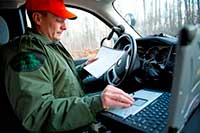- Details
 Wolf & Coyote Tracks
Wolf & Coyote Tracks
(Provided by Michigan DNR)
Michigan will begin its next wolf tracking survey Feb. 16 through March 13 to detect the presence of gray wolves in the northern Lower Peninsula.
"The probability of observing an actual wolf or its tracks in the Lower Peninsula is low," said DNR wildlife biologist Jennifer Kleitch. "It's helpful to have as many eyes as possible looking, so public reports are important for this survey."
- Details
(Provided by Michigan DNR)
 A trapper pulls a muskrat out of an ice-covered marsh.Doug Reeves remembers his first time as though it were yesterday.
A trapper pulls a muskrat out of an ice-covered marsh.Doug Reeves remembers his first time as though it were yesterday.
The first thing I ever caught was an ermine, a white weasel, said Reeves, assistant chief of the Department Natural Resources Wildlife Division and a lifelong trapper. I sold it for 50 cents to a traveling fur buyer. To me that was big time.
He was 9 years old. And he was hooked. The next year he got three traps and starting chasing muskrats. He progressed from there.
Back then you had to be 12 years old to trap beaver, he said. The first one I got I brought home in the basket of my sisters fat-tire bike.
- Details
The Michigan DNR announced that a discount of just over 10 percent has been approved for non-resident annual fishing licenses for 2015.
The cost of the non-resident annual fishing license will go from $76 to $68 starting on March 1.
The decision came during yesterday's meeting of the Natural Resources Commission.
Michigan's fishing license options originally were restructured March 1, 2014. Since that time a review of feedback from customers, local businesses and others suggested substantial merit in discounting the annual fishing license fee charged to non-residents. In response to those concerns the DNR has discounted the price.
"Discounting the non-resident annual fishing license will encourage more out-of-state visitors to come and experience Michigan's world-class fisheries - and the many other outstanding recreational opportunities available in this state," said DNR Director Keith Creagh.
- Details
(Provided by Michigan DNR)
 Field officers maintain contact with the RAP room when a report is filed.The sign - Law Enforcement Communications Section - is as nondescript as the standard office door on an unadorned white wall deep within the recesses of Lansing's Constitution Hall.
Field officers maintain contact with the RAP room when a report is filed.The sign - Law Enforcement Communications Section - is as nondescript as the standard office door on an unadorned white wall deep within the recesses of Lansing's Constitution Hall.
But inside that secured door is a non-stop center of activity: the RAP Room.
The RAP (Report All Poaching) Room is staffed 24/7 by as many as seven personnel at a time. It is the main link between the public and the Michigan DNR Law Enforcement Division.
The Report All Poaching hotline was created in 1980 when the state Legislature designated a small percentage of the money raised by hunting and fishing license sales toward developing an easy method for citizens to report illegal hunting and fishing activity to the DNR. It has grown into a 1,000-square-foot room, outfitted with the kind of high-tech equipment one often finds at county or state regional dispatch centers. At each of the workstations, six computer dispatchers working in the RAP Roomscreens give dispatchers as much information as they could possibly need to direct the state's conservation officers to the scene of a complaint - and what the COs need to know once they get there.
Computer screens display information on the current location of COs (through the GPS monitoring equipment on their patrol vehicles), as well as access to the state's Law Enforcement Information Network, the state's licensing records, the radio system, the Internet, and even the criminal history of those whom the COs contact.
- Details
The Michigan DNR announced that multiple changes have been made to Michigan's Master Angler program, which allows anglers to submit large fish they have caught for recognition. The program has been in place since 1973.
The Master Angler program recognizes two categories of catches: catch-and-keep and catch-and-immediate-release. Previously, the catch-and-keep category was determined by the weight of the fish caught, but that requirement has been removed and replaced with a length requirement. Now recognition in both categories will be awarded based on an established minimum length for each recognized species. Verified entries will receive the Master Angler patch. Only one patch will be awarded for both catch-and-keep and catch-and-immediate-release entries. No more than one patch per species will be awarded to each angler per year.


